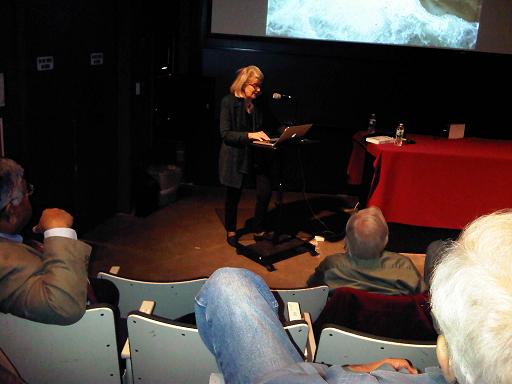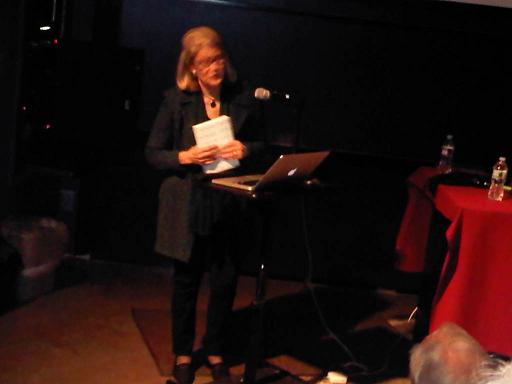Contribute
| Harvard Outreach Lecture: India – A Sacred Geography |
C. Gopinath
11/22/2011
On November 6, 2011, Professor Diana Eck, Harvard University, gave a stimulating talk on the connections between geography, spirituality and identity in India. The lecture was a part of a series on the theme “Indian Society through the Agesâ€, organized by the Outreach Committee of the Department of South Asian Studies, Harvard University.
Prof. Eck began by describing how the traditional view was of Banaras as ‘the’ sacred location for the Hindus, just as Mecca was for the Muslims and Jerusalem for the Jews. However, her explorations have led her on a journey of discovery of locations of holy pilgrimage for the Hindus causing her to wonder about the landscape of rivers, mountains and forests that make a location “auspicious.†Her scholarly studies into the myths and legends help her build her thesis that several locations combine into a network termed, a sacred geography, that assumes significance in the religiosity of the Hindus with their association to gods, events, myths, and region. Her work is to be published in a new book “India- A Sacred Geographyâ€, due to be released in March of 2012.
She took the audience through a visual journey of her thesis by illustrating key points of the narrative with brilliantly shot pictures of posters, people, and places. Her illustrations from the mythological literature helped explain the connection between gods, location, and beliefs. Thus, although Kashi (Banaras) is very important, so is Guptakashi, on the way to Kedarnath and the banks of the Mandakini River, which is also endowed with a manikarnika kund bathed by two springs representing the Ganga and the Yamuna, and laying claim to have been visited by the Pandava brothers. Similarly, the Vindhyas, a low-lying mountain range in the middle of the country, is believed to have bowed down to the sage Agastya. Just as the traditional triveni is located at Prayag, so also a triveni is at Rameshwaram at the southern tip of the country where the two seas that collect all the sacred rivers meet with the Indian Ocean.
Hindu beliefs are closely associated with the sacred landscape. As Prof. Eck says, ‘We are talking of manifestations that are more powerful than the temples.’ Thus, we believe that the Ganges flows down to the earth, Narmada flows out of the body of Siva, and the svayambhu linga emerges from the earth.
Prof. Eck explained the importance of the tirthayatra, or pilgrimage, in making the connections between the gods, myths, and the region. As people travel on pilgrimages, they follow traditions that make geographic connections. They desire to visit the 12 Jyotirlingas (which are spread around the country), or seek to carry the water from the Ganges to offer it at Rameswaram. In the process, it has given India an identity as a nation that appears to precede any political boundary setting.
The speaker explained how the traditions and pilgrimages are thriving even in modern times due to the conveniences of travel now available. The construction of the Sardar Sarovar dam across the Narmada has only re-routed the practice of circumambulation of the Narmada and visiting the 480 tirthas along the way. The bathers at the Kumbhmela, seekers to Vaishnodevi, or devotees at Sabarimalai continue to increase in vast numbers. At the conclusion of her talk, Prof. Eck read out a passage from her book to present a theological understanding of her research that the divine can be discovered almost anywhere, and is an ‘affirmation that everywhere is sacred.’
The talk was followed by were several questions and comments from the audience. Some sought clarifications about specific temples, and other locations. One participant pointed out how the nature of the sacred geography was that it was an evolving one, and the objective of the tirtha yatras may themselves be seen as encouraging pluralism. There were questions on a secularist view of the landscape followed by the discussion on the unity of Indian culture in the subcontinent irrespective of religious beliefs or provincialism. Comments from the audience cited tantric origin of various beliefs, particularly the significance of Triveni in Hindu understanding. The session ended with
the greetings of Islamic celebration of Id, which was observed on the day.
This lecture was the tenth event in the series that began in November, 2009. In his welcome, Prof. Bijoy Misra, Convener of the Outreach Committee, gave a brief description of the evolution of this series of lectures and the topics covered so far and introduced the speaker as an activist and a scholar of great recognition. The Outreach lectures over the past 16 years have covered several aspects of Indian Studies, in culture, arts, history, religion, architecture, philosophy, languages and literature.
The next lecture in the series will be by Professor Francis Clooney of Harvard Divinity School on the topic “Hindu Theology.†It’s scheduled for December 11 in Hall A of the Harvard University Science Center at 1 Oxford Street, Cambridge. Outreach lectures are free and designed as a forum for the community participation in the matters of scholarly research in understanding the history, traditions and culture of South Asia. All are cordially invited. Further information on the lectures can be obtained from Bijoy Misra bmisra@fas.harvard.edu, C Gopinath cgopinath2000@yahoo.com, Chandrakanta Shah chandu420@gmail.com, or Thomas Burke thomasburke@aol.com.
You may also access this article through our web-site http://www.lokvani.com/

